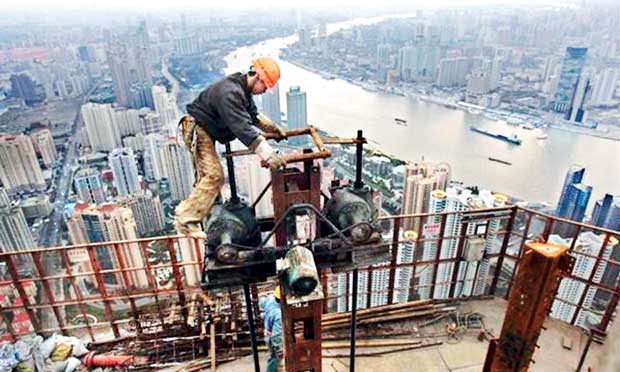30 Mar 2016 - {{hitsCtrl.values.hits}}

By Shiro Armstrong and Tom Westland
After a turbulent 2015, China’s major stock exchanges took another hit in January. Chinese authorities have in the past clumsily tried to stop the free fall in markets with various degrees of success. But for China to avoid a middle-income trap and become a high-income country, it will need to develop and trust the markets instead of distorting them with unsustainable growth, just like its Northeast Asian neighbours did.
The notion of a ‘middle-income trap’ has gained currency in recent years and focused attention on the policies that facilitate economic growth in middle-income countries.
East Asia is home to a number of economies that have managed to graduate from middle-income status to be classified into the high-income group of economies. Japan, South Korea, Taiwan and Singapore all caught up to technologically advanced countries and their peoples enjoy high incomes.
Yet, globally only 13 of 101 middle-income countries have been able to move to high-income status since 1960. China and other countries in Southeast Asia have succeeded in emulating rapid catch-up growth out of poverty but have yet to make the transition to high income. Thailand and Malaysia appear stuck in the middle. India, the Philippines and Indonesia are at a lower level of development but are growing fast and policymakers are already beginning to contemplate how they can join the ranks of the world’s advanced economies.
So how can countries escape the trap?
Openness to international trade and investment — such as lower tariffs and openness to foreign investment — is widely recognised as a necessary condition for rapid catch-up growth in developing countries. But these conditions are unlikely to be sufficient for countries that wish to
move to high income.
As countries approach the global technology frontier, institutions that encouraged growth (or at least did not slow it) in the catch-up phase can begin to hinder economic growth. Often these involve government intervention — including regulation, cheap credit and direct government ownership — in favour of specific sectors or firms. Continuing a path of economic growth that will lead countries out of the middle-income trap requires institutions that foster firm entry and exit, competitive domestic product and factor markets and well-developed financial markets that allocate capital efficiently.
As middle-income countries are defined by their distance from the global technology frontier, the ability to upgrade, catch up and innovate is important to their closing that distance. To reach the frontier, countries need to be open to ideas and have institutions that allow for more complex interactions across the economy. That would seem to include good governance characterised by decentralised economic decision-making.
Institutions suited to growth and development differ at different stages of development. Those considered second-best practice such as industrial policy or quick fixes and market suppression that substitutes for functioning markets may serve developing countries sufficiently well, and Asian countries demonstrate that this is the case during catch-up growth. Some barriers to entry and the existence of economic rents, while inefficient in theory, may stimulate entrepreneurship, investment and exports in countries at very low levels of development. Yet, these second-best policies become a hindrance once a country moves closer to the technology frontier. In particular, strong growth in middle-income countries requires well-functioning capital markets. Developing East Asian economies were no different from other developing countries in having shallow, underdeveloped capital markets.
Northeast Asian economies and China in particular, overcame some of those constraints with capital market distortions coupled with export-favouring industrial policies. Yet, as China grows richer and more technologically advanced, and hence as innovation-based growth becomes more important, it will need to reform underlying market failures in capital markets. The experience of countries in the region tends to show that middle-income countries that have less distorted capital markets relative to their stage of development tend to grow faster. This doesn’t mean complete financial deregulation is the answer — as Asian countries learnt in the Asian financial crisis and we all learnt from America more recently, rigorous prudential regulation is essential. But the regulations governing capital markets in middle-income countries should not be tilted in favour of preferred sectors or
well-connected firms.
The problem for many of Asia’s middle-income countries looking to graduate to high-income status is that generating the political will to make the necessary reforms. Favoured firms will fight bitterly to resist changes that threaten their market power. There is some evidence that democracies are more likely to make the kinds of financial sector reforms that are needed to escape the trap, which may suggest that political structures need to change in the region’s middle-income countries.
The middle-income trap is an economic phenomenon, but escaping it through deeper openness and financial reform is a political challenge. And it’s one that leaders in China, Thailand, Malaysia and other middle-income countries must rise to.
(Courtesy East Asia Review)
(Shiro Armstrong is Co-director of the Australia–Japan Research Centre and Co-Editor of East Asia Forum at The Australian National University. Tom Westland is a graduate student at the Institut des hautes études internationales et du développement)
24 Nov 2024 4 hours ago
24 Nov 2024 7 hours ago
24 Nov 2024 8 hours ago
24 Nov 2024 8 hours ago